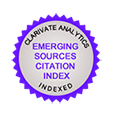Social implications of prevalence of hemolysins in women with group 'OR', their relationship with incompatibility ABO neonatal
Abstract
The ABO blood system plays a crucial role in blood group classification, being essential to prevent adverse reactions during transfusions due to the presence of anti-A and anti-B antibodies in individuals with blood group O. These antibodies can trigger hemolysis when they come into contact with red blood cells expressing A or B antigens. This study focused on evaluating the prevalence of maternal hemolysins and their influence on ABO incompatibility in newborns, analyzing a sample of 177 pregnant women in the third trimester. Rigorous statistical methods were applied, including the Chi-square test and the T-test for the difference of proportions, to determine the associated risk between the presence of hemolysins and ABO incompatibility. The results revealed that 71.8% of women had maternal hemolysins, although only 3.6% were classified as dangerous. ABO incompatibility was observed in 10.7% of the sample, identifying a risk of 40% in blood group A newborns and 60% in blood group B newborns. These results highlight the importance of appropriate monitoring and management of ABO incompatibility and maternal hemolysins, not only to prevent immediate medical complications, but also to mitigate the long-term societal impact; ensuring the health and well-being of newborns and promoting safe and equitable medical practices.
Keywords: Blood groups, Antibodies, Hemolysins, ABO incompatibility.
Downloads
Published
How to Cite
Issue
Section
License
Copyright (c) 2024 Editorial "Universo Sur"

This work is licensed under a Creative Commons Attribution-NonCommercial-NoDerivatives 4.0 International License.
La editorial "Universo Sur", de la Universidad de Cienfuegos, publica el contenido de la Revista "Universidad y Sociedad" bajo una Licencia Creative Commons Atribución-NoComercial-SinDerivar 4.0 Internacional.
© Podrá reproducirse, de forma parcial o total, el contenido de esta publicación, siempre que se haga de forma literal y se mencione la fuente.










